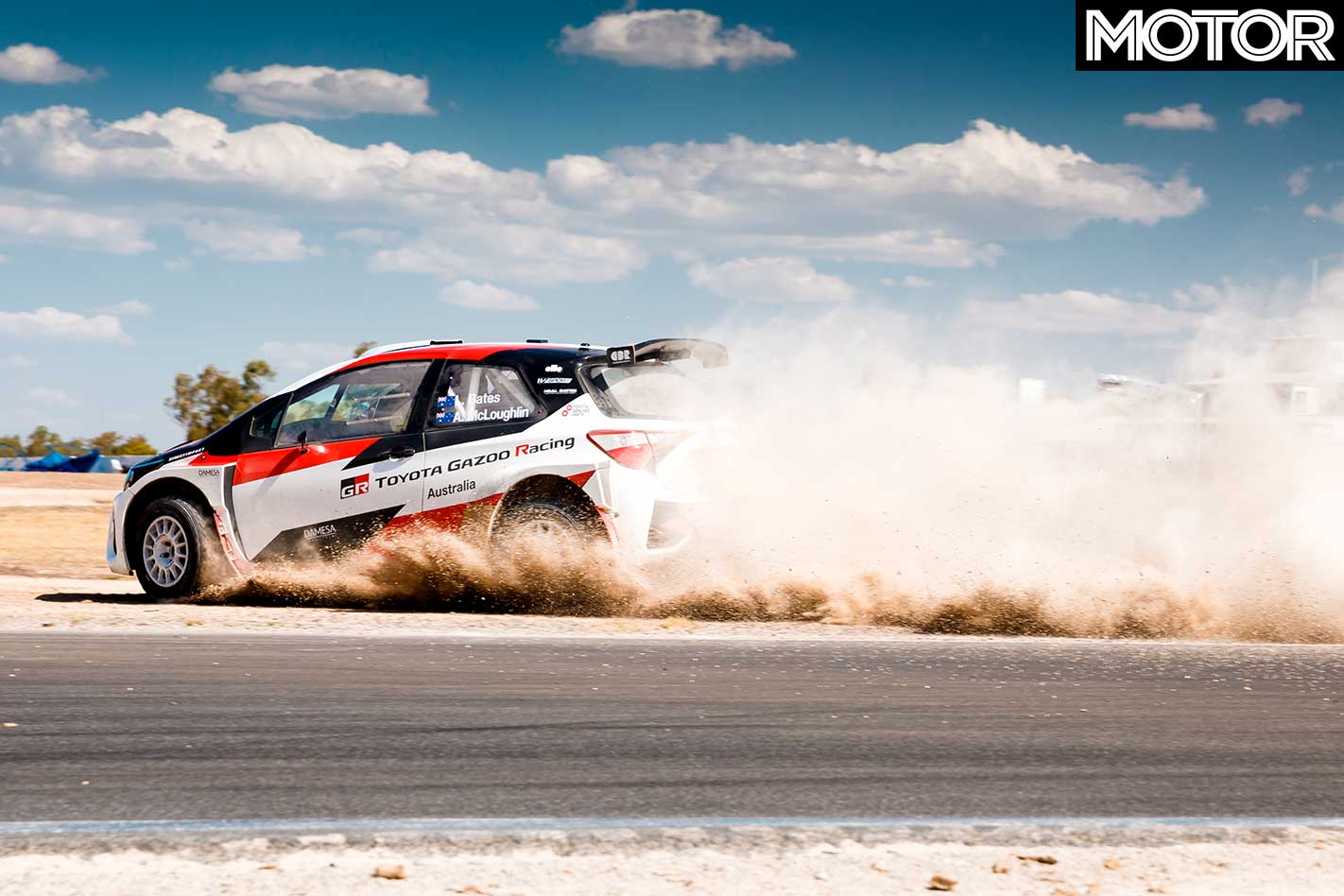What exactly is a Toyota Yaris AP4? I’m glad you asked. With no more Lancer Evolution, rallyists were left with a choice of a Subaru WRX STI or nothing, so the AP4 regulations were conceived to allow essentially any basic shopping car to be transformed into a turbocharged, all-wheel drive forest flyer.
The concept is very similar to the R5 machines that compete in the WRC, but without the need for FIA homologation and at a lower cost than the roughly $400,000 needed to land a new R5 car in Australia. Neal Bates admits that if Toyota made a Yaris R5 they’d probably be using it, but since it doesn’t his team began the tricky process of creating a rally car from scratch.

As Neal says: “It’s been an incredibly tough project.” With no template to work from, his team has spent 18 months using 30 years of rallying experience to develop the Yaris to the point where it can now hold its own against the latest factory machinery from Europe. And now I get to drive it.
Thankfully, Harry is on hand to teach me the ropes but, cleverly, he’s brought Lewis’s car for me to learn them in. I’ve dabbled in rallying before but a modified Daihatsu Charade isn’t exactly a natural stepping stone to a 300bhp ARC front-runner. International driving experience means left-hand drive is okay – the Yaris is left-hook to prepare Harry for any future overseas outings – but I’ve never used a sequential ’box before.
It’s not difficult, as it turns out. The clutch is only required from rest; after that, simply pull or push the lever as required, but upshifts in particular require quite a bit of muscle. A full weekend’s rallying – including hundreds of kilometres of transport stages – would require a lot of stamina.

AP4 regulations require a 1.6-litre engine so Toyota’s 2ZZ 1.8-litre four was destroked and a turbo added, breathing through a 34mm inlet restrictor. Measure that with your fingers, it’s not very wide. Nevertheless, the Yaris produces 224kW and 420Nm and weighs just 1230kg so with extremely short gearing – top speed is less than 200km/h – it’s a reasonably rapid machine.
The steering is very light, so light that I wonder how Harry, who likes to drive in the modern Sebastien Loeb/Ogier style of leaning on the front tyres, manages to find the required level of communication. Talent, I suppose. Luckily, I’m a similar height to the Bates boys so the driving position is about right, albeit quite high. With its gravel-spec setup, the Yaris sits equally high and its softness leads to big-time body roll.

This softness allows lots of weight transfer, key to getting the Yaris to turn as it runs no centre diff, just a fixed 50:50 torque split. “These new breed of cars are set up quite soft,” explains Harry. “I’ll usually run quite a bit of front bias because I’m looking to be really aggressive under brakes, because if it’s on its nose I can get the turn that I want.”
As such, the Yaris loves to slide. A dab of brakes and a flick of steering sets it up and it’s then child’s play to use the pedals to endlessly adjust its attitude. Swapping tarmac for gravel only makes the process easier, the aim being to swing the rear out wide on corner entry so all four wheels are pointing straight towards the exit for maximum traction.

Clearly satisfied I’m not a complete liability, Harry tweaks a small knob on the centre console and engages the Yaris’s anti-lag system, keeping the turbo spinning constantly for instant power. What’s remarkable is how easy the Yaris is to drive. The light steering, progressive chassis and responsive, torquey engine make it second nature to indulge in huge slides under power or brakes.
But it’s not Harry and Lewis’s job to have fun. They need to win and the Yaris AP4 is so friendly I wonder if it would be easy to let time slip away without realising it. What’s certain is I need a Yaris AP4; no road car can deliver this amount of entertainment. Neal is more than happy to oblige, but wants $250,000 in return. For sale: one kidney, slightly used.
Toyota Australia’s Motorsports involvement
FAST FACTS 2019 Toyota Yaris AP4 BODY: 3-door, 2-seat hatch DRIVE: all-wheel ENGINE: 1613cc inline-4cyl, DOHC, 16v, turbo POWER: 224kW TORQUE: 420Nm WEIGHT: 1230kg (dry) POWER-TO-WEIGHT: 182kW/tonne TRANSMISSION: 6-speed sequential manual SUSPENSION: struts, coil springs, anti-roll bar (f/r) STEERING: hydraulically assisted rack-and-pinion BRAKES: 300mm ventilated/slotted discs, 4-piston calipers (f); 300mm ventilated/slotted discs, 4-piston calipers (r) WHEELS: 15.0 x 7.0-inch (f/r) TYRES: MRF rally tyres; 205/65 R15 (f/r) PRICE: $250,000 (approx)






